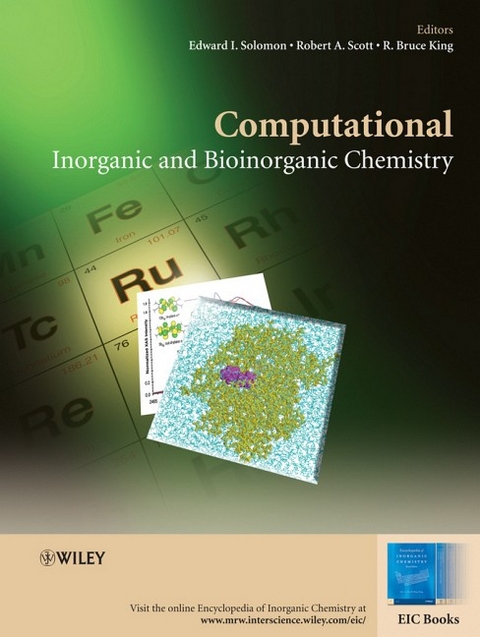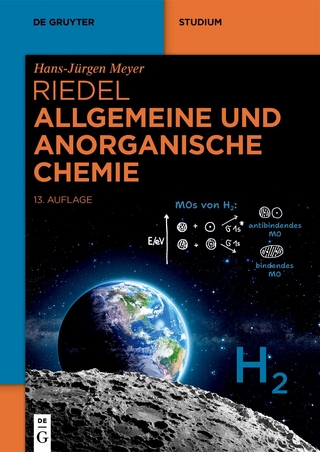
Computational Inorganic and Bioinorganic Chemistry
John Wiley & Sons Inc (Verlag)
978-0-470-69997-3 (ISBN)
- Titel z.Zt. nicht lieferbar
- Versandkostenfrei innerhalb Deutschlands
- Auch auf Rechnung
- Verfügbarkeit in der Filiale vor Ort prüfen
- Artikel merken
The purpose of this EIC Book is to provide state-of-the-art presentations of quantum mechanical and related methods and their applications, written by many of the leaders in the field. Part 1 of this volume focuses on methods, their background and implementation, and their use in describing bonding properties, energies, transition states and spectroscopic features. Part 2 focuses on applications in bioinorganic chemistry and Part 3 discusses inorganic chemistry, where electronic structure calculations have already had a major impact. This addition to the EIC Book series is of significant value to both experimentalists and theoreticians, and we anticipate that it will stimulate both further development of the methodology and its applications in the many interdisciplinary fields that comprise modern inorganic and bioinorganic chemistry.
This volume is also available as part of Encyclopedia of Inorganic Chemistry, 5 Volume Set.
This set combines all volumes published as EIC Books from 2007 to 2010, representing areas of key developments in the field of inorganic chemistry published in the Encyclopedia of Inorganic Chemistry. Find out more.
Robert A. Scott is Distinguished Research Professor of Chemistry and Biochemistry and Molecular Biology at theUniversity ofGeorgia. Trained as an inorganic chemist, he currently conducts research in the areas of biophysics, spectroscopy, and molecular cell biology. He has published more than 150 articles in the general area of biological inorganic chemistry, served as editor or co-editor of several books, and is active in professional service, organizing many meetings and symposia, most recently acting as Chair of the 2007 Metals in Biology Gordon Research Conference. He currently serves as President of the Society of Biological Inorganic Chemistry. He has served as the bioinorganic subject editor of the Encyclopedia of Inorganic Chemistry since its inception. R. Bruce King is Regents' Professor Emeritus of Chemistry and a Professorial Fellow in the Center for Computational Chemistry at the University of Georgia. In recent years, after a 40-year career in synthetic inorganic and organometallic chemistry and related areas of molecular catalysis, he has increasingly become involved in various computational inorganic chemistry projects in collaboration with colleagues at the University of Georgia as well as universities in Romania and China. Dr. King has published more than 675 journal articles and edited or authored more than 20 books including more than 100 journal articles since 2000. He has won American Chemical Society Awards in Pure Chemistry (1971) and Inorganic Chemistry (1991). He has organized international conferences in the areas of inorganic chemistry, boron chemistry, mathematical chemistry, and the Periodic Table, all of which resulted in edited books. He was the American Regional Editor of the Journal of Organometallic Chemistry for 17 years (1981–1998) and served as Editor-in-Chief for the first two editions (1994 and 2005). Edward I. Solomon is a Monroe E. Spaght Professor of Humanities and Sciences and SSRL Professor at Stanford University. His research interests are in physical-inorganic, bioinorganic and theoretical-inorganic chemistry. He has published over 530 articles and edited 8 books. Solomon is a member of the National Academy of Sciences, the American Academy of Arts and Sciences, and a Fellow of the AAAS. He has received the ACS Awards in Inorganic Chemistry, Distinguished Service in the Advancement of Inorganic Chemistry, and the Ira Remsen Award, the Centenary Medal of the Royal Society of Chemistry, the Wheland Medal from the University of Chicago, the Frontiers in Biological Chemistry Award from the MPI, Mülheim, the Chakravorty Award from the Chemical Research Society of India and the Bailar Medal from the University of Illinois. He has held numerous lectureships including the First Glen Seaborg Lecturership at UC Berkeley and has been an Invited Professor at the University of Paris, Orsay, La Plata University, Argentina, Tokyo Institute of Technology, and the TATA Institute in Bombay, India. He is an Associate Editor in Inorganic Chemistry and on 10 Editorial Advisory Boards.
List of Contributors. Series Preface.
Volume Preface.
Part 1: Methods.
Calculation of Bonding Properties (Gernot Frenking and Moritz von Hopffgarden).
Determining Transition States in Bioinorganic Reactions (Marcus Lundberg and Keiji Morokuma).
Quantum Mechanical/Molecular Mechanical (QM/MM) Methods and Applications in Bioinorganic Chemistry (Ulf Ryde).
Ab initio and Semiempirical Methods (Serge I. Gorelsky).
Spectroscopic Properties of Proten-Bound Cofactors: Calculation by Combined Quantum Mechanical/Molecular Mechanical (QM/MM) Approaches (Mahesh Sundararajan, Christoph Riplinger, Maylis Orio, Frank Wennmohs and Frank Neese).
Spectroscopic Properties Obtained from Time-Dependent Density Functional Theory (TD-DFT) (Jochen Autschbach).
Nuclear Magnetic Resonance (NMR) Parameters of Transition Metal Complexes: Methods and Applications (Martin Kaupp and Michael Bühl).
Calculation of Reduction Potential and pKa.
Quantum-Chemistry-Centered Normal Coordinate Analysis (QCC-NCA): Application of NCA for the Simulation of the Vibrational Spectra of Large Molecules (Nicolai Lehnert).
Molecular Mechanics in Bioinorganic Chemistry (Robert J. Deeth).
Multiconfigurational Quantum Mechanics (QM) for Heavy Element Compounds (Björn O. Roos).
Approximate Density Functionals: Which Should I Choose? (Dmitrij Rappoport, Nathan R. M. Crawford, Filipp Furche and Kieron Burke).
Spin Contamination in Inorganic Chemistry Calculations (Jason L. Sonnerberg, H. Bernhard Schlegel and Hrant P. Hratchian).
Gaussian Basis Sets for Quantum Mechanical (QM) Calculations (Kirk A. Peterson).
Part 2: Case Studies – Bioinorganic.
Modeling Metalloenzymes with Density Functional and Mixed Quantum Mechanical/Molecular Mechanical (QM/MM) Calculations: Progress and Challenges (Richard A. Friesner).
Broken Symmetry States of Iron-Sulfur Clusters (Louis Noodleman and David A. Case).
Water Oxidation by the Manganese Cluster in Photosynthesis (Per E. M. Siegbahn).
Nature of the Catecholate-Fe(III) Bond: High Affinity Binding and Substrate Activation in Bioinorganic Chemistry (Edward I. Solomon, Monita Y. M. Pau and Rosalie K. Hocking).
Computational Studies: B12 Cofactors and Their Interaction with Enzyme Active Sites (Thomas C. Brunold).
Reaction Coordinate of Pyranopterin Molybdenum Enzymes (Martin L. Kirk, Sushilla Knottenbelt and Abebe Habtegabre).
Electronic Structure Calculations: Dinitrogen Reduction in Nitrogenase and Synthetic Model Systems (Felix Tuczek).
Hydrogenases: Theoretical Investigations Towards Bioinspired H2 Production and Activation (Maurizio Bruschi, Giuseppe Zampella, Claudio Grego, Luca Bertini, Piercarlo Fantucci and Luca De Gioia).
Computational Studies: Cisplatin (Yogita Mantri and Mu-Hyun Baik).
Computational Methods: Modeling of Reactivity in Zn-Containing Enzymes (Jon I. Mujika, Adrian J. Mulholland and Jeremy N. Harvey).
Combined Density Functional Theory (DFT) and Electrostatics Study of the Proton Pumping Mechanism in Cytochrome c Oxidase (Jason Quenneville, Dragan M. Popović and Alexei A. Stuchebrukhov).
Computational Studies: Proton/Water Coupling to Metal in Biological Reaction Mechanisms (Y. Bu and R. I. Cukier).
Computational Studies: Chemical Evolution of Metal Sites (Kasper P. Jensen).
Part 3: Case Studies – Inorganic.
Electronic Structure Calculations: Transition Metal-NO Complexes (Abhik Ghosh, Jeanet Conradie and Kathrin H. Hopmann).
Structural Origins of Noninnocent Coordination Chemistry (Robert K. Szilagyi).
Electronic Structure of Metal-Metal Bonds (John E. McGrady).
Computational Methods: Transition Metal Clusters (Régis Gautier, Jean-François Halet and Jean-Yves Saillard).
Computational Methods: Heteropolyoxoanions (Josep M. Poblet and Xavier López).
Electronic Structure Calculations: Metal Carbonyls (Chantal Daniel).
Potential Energy Surfaces for Metal-Assisted Chemical Reactions (Tiziana Marino, Maria del Carmen Michelini, Nino Russo, Emilia Sicilia and Marirosa Toscano).
Computational Methods: Lanthanides and Actinides (M. Dolg and X. Cao).
Spin-Orbit Coupling: Effects in Heavy Element Chemistry (Nikolas Kaltsoyannis).
Noble Gas Compounds: Reliable Computational Methods (David A. Dixon).
Computational Studies: Boranes (Oottikkal Shameema and Eluvathingal D. Jemmis).
Multiple Aromaticity, Multiple Antiaromaticity, and Conflicting Aromaticity in Inorganic Systems (Dmitry Yu. Zubarev and Aledander I. Boldyrev).
Theoretical Aspects of Main Group Multiple Bonded Systems (Ioan Silaghi-Dumitrescu, Petronela Petrar, Gabriela Nemes and R. Bruce King).
Index.
| Erscheint lt. Verlag | 1.11.2009 |
|---|---|
| Reihe/Serie | EIC Books |
| Verlagsort | New York |
| Sprache | englisch |
| Maße | 218 x 285 mm |
| Gewicht | 1928 g |
| Themenwelt | Naturwissenschaften ► Chemie ► Anorganische Chemie |
| ISBN-10 | 0-470-69997-3 / 0470699973 |
| ISBN-13 | 978-0-470-69997-3 / 9780470699973 |
| Zustand | Neuware |
| Informationen gemäß Produktsicherheitsverordnung (GPSR) | |
| Haben Sie eine Frage zum Produkt? |
aus dem Bereich


